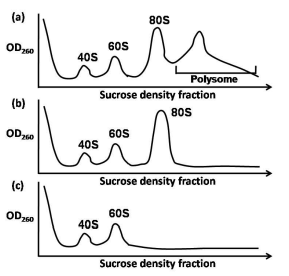 Multiple Choice Questions
Multiple Choice QuestionsIn order to ensure that only fully processed mature mRNAs are allowed to be exported to cytosol, pre-mRNAs associated with snRNPs are retained in the nucleus. To demonstrate this, an experiment was performed where a gene coding a pre-mRNA with a single intron was mutated either at the 5' or 3' splice sites or both the splice sites.
Given below are a few possible outcomes:
A. Pre-mRNA having mutation at both the splice sites will be retained in the nucleus because of the presence of bound snRNPs.
B. Pre-mRNA having mutation at both the splice sites will be exported to cytosol because of the absence of bound snRNPs.
c. PRe-mRNA mutated at either 3' or 5' splice sites will be retained in the nucleus because of the presence of bound snRNPs.
d. Pre-mRNA mutated at either 3' or 5' splice sites will be exported to cytosol because of the absence of bound snRNPs.
Choose the correct combination of the possible outcomes:
B and C
A and D
B and D
A and C
Polysome profiling of cells treated with three hypothetical translation inhibitors is shown in the plots below. These three inhibitors are
(i) CHP- leaky inhibitor of translation
(ii) LTM- arrests ribosome at the initiation codon.
(iii) PTM- inhibits ribosome scanning

Match the polysome profile to the inhibitor
(i) - a; (ii) - b; (iii) - c
(i) - b; (ii) - c; (iii) - a
(i) - c; (ii) - b; (iii) - a
(i) - a; (ii) - c; (iii) - b
In mammals, CG rich sequences are usually methylated at C, which is a way for marking genes for silencing. Although the promoters of housekeeping genes are often associated with CpG islands yet they are expressed in mammals. Which one of the following best explains it?
Methylation of cytosine does not prevent the binding of RNA Pol II with the promotes, so housekeeping genes are expressed.
During housekeeping gene expression, the enzyme methyltransferase is temporarily silenced by miRNA, thus shutting down global methylation.
Unlike within the coding region of a gene, CG rich sequences present in the promoters of active genes are usually not methylated.
As soon as the cytosine is methylated in the promoter region, the enzymes of DNA repair pathways remove the methyl group, thereby ensuring gene expression.
Telomerase, a protein-RNA complex, has a special reverse transcriptase activity that completes the replication of telomeres during DNA synthesis. Although it has many properties similar to DNA polymerase, some of them are also different. Which one of the following properties of telomerase is different from that of DNA polymerase?
Telomerase requires a template to direct the addition of nucleotides.
Telomerase can only extend a 3'-OH end of DNA.
Telomerase does not carry out lagging strand synthesis.
Telomerase acts in a processive manner.
In Trypanosomes, a 35 base leader sequence is joined with several different transcripts making functional mRNAs. The leader sequence is joined with the other RNAs by
a specific RNA ligase
the process of trans-splicing
a nucleophilic attack caused by a free guanine nucleotide
a nucleophilic attack by a 2' OH of an internal A present in the leader sequence.
Phytochrome-mediated control of photomorphogenesis is linked to many other gene functions. The following statements are made on the mechanism of phytochrome action:
A. Phytochrome function requires COP1, an E3 ubiquitin ligase that brings about protein degradation.
B. COP1 is slowly exported from the nucleus to the cytoplasm in the presence of light.
C. HY5 is targeted by COP1 for degradation in the presence of light.
D. HY5 is a transcription factor involved in photomorphogenetic response.
Which one of the following combinations is correct?
A, B, and C
B, C, and D
A, B, and D
A, C, and D
Mafair genes (hypothetical) consist of a super family of transcription factor. They are found in 4 clusters in mammals; in 2 clusters in insects; and in a single cluster in an ancestor to insects. These data are consistent with all of the following explanations EXCEPT:
Two successive genome duplication events occurred between ancestral organism and vertebrates.
The first duplication may have taken place before the divergence of vertebrates.
Exon shuffling exclusively produced such cluster.
Whole-genome duplications could lead to such observations.
Polynucleotide kinase (PNK) is frequently used for radiolabeling DNA or RNA by phosphorylating 5'-end of non-phosohorylated polynucleotide chains. Which of the following statements about PNK is not true?
PNK catalyzes the transfer of α-phosphate from ATP to 5'-end of polynucleotide chains (DNA or RNA).
PNK has 3'-phosphatase activity.
PNK is inhibited by small amount of ammonium ions.
PNK is a T4-bacteriophage-encoded enzyme.
In eukaryotes, precursors of micro RNAs (miRNAs) and small interfering RNAs (siRNAs) are usually synthesized by
RNA Pol I and III, respectively
RNA Pol III and I, respectively
Only RNA Pol I
Only RNA Pol II
Aminoacyl tRNAs are escorted to the ribosome by the elongation factor
EF-Ts
EF-G
EF-Tu
eEF-2
C.
EF-Tu
Aminoacyl tRNAs are escorted to the ribosome by the elongation factor EF-Tu.
